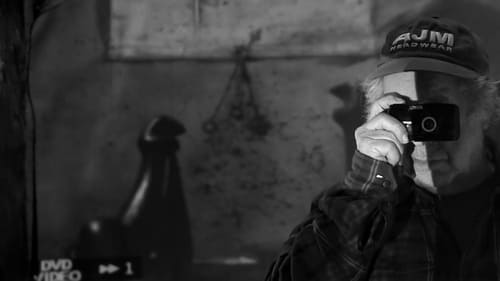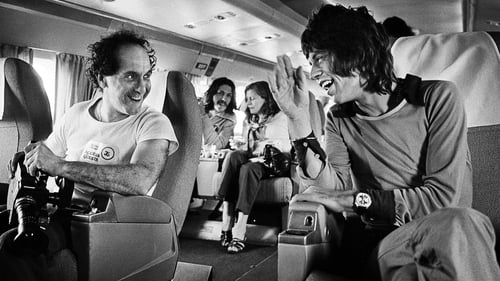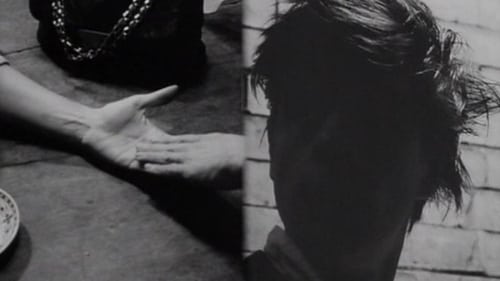Robert Frank
出生 : 1924-11-09, Zurich, Switzerland
略歴
Robert Frank is one of the most acclaimed photographers of the 20th century. He is best known for his seminal book "The Americans", featuring photographs taken by the artist in the mid-1950s as he traveled across the U.S. on a Guggenheim fellowship. Robert Frank is also known as a filmmaker.

Director
The 94-year-old Robert Frank’s unique recordings of his fellow artists Harry Smith and Allen Ginsberg, which he had salvaged from his own archive for Harry Smith at the Breslin Hotel.

Self
The life and work of Robert Frank—as a photographer and a filmmaker—are so intertwined that they're one in the same, and the vast amount of territory he's covered, from The Americans in 1958 up to the present, is intimately registered in his now-formidable body of artistic gestures. From the early '90s on, Frank has been making his films and videos with the brilliant editor Laura Israel, who has helped him to keep things homemade and preserve the illuminating spark of first contact between camera and people/places. Don't Blink is Israel's like-minded portrait of her friend and collaborator, a lively rummage sale of images and sounds and recollected passages and unfathomable losses and friendships that leaves us a fast and fleeting imprint of the life of the Swiss-born man who reinvented himself the American way, and is still standing on ground of his own making at the age of 90.

Director
Alfred Leslie is a pivotal American artist-painter-filmmaker whose work spans the past fifty years. A contemporary of the Abstract Expressionists and a key figure in the extraordinary social milieu of downtown New York from the 1950s and 60s to the present, his own canvases were amongst the most revered of his peers. In 1964 he made 'Pull My Daisy' with the photographer Robert Frank and in 1966 collaborated with the inimitable poet Frank O'Hara on 'The Last Clean Shirt'. Leslie dramatically moved away from abstraction to make giant almost hyper-real portraits, the majority of which were destroyed in the now infamous fire that ripped through his studio and its neighboring blocks on October 17, 1966. This devastating event, that completely destroyed paintings, films and manuscripts, continues to inform his work today.

Director
Sanyu (1901-1964), an important Chinese artist, was a friend of Robert Frank's who died in anonymity in Paris. In this film portrait, Frank creates a requiem that includes dramatic and documentary scenes set in Paris, and a chronicle of his trip to Taipei to attend Sotheby's auction of the paintings Sanyu left him."

Director
Robert Frank diary/memory film.

Director
In a simple, sensitive and entertaining video film, Robert Frank accompanies his local newspaper delivery boy during his morning round one chilly winter day in Nova Scotia.

A small film crew goes through several locations including Europe, New York and Mexico.

Director
Simple objects, photographs, and events prompt Frank to self-conscious rumination. From his homes in New York and Nova Scotia and on visits to friends, the artist contemplates his relationships, the anniversary of his daughter's death, his son's mental illness, and his work.

Director
Video by filmmaker Robert Frank of Patti Smith's song Summer Cannibals

Cinematography
In an empty lot in Harlem, an elite group of New Yorkers prepares for a book-signing party given in honor of a writer who never shows up. Local residents, dealing with the practicality of life, look on as the guests obsess about identity, status, and success.

Director
In an empty lot in Harlem, an elite group of New Yorkers prepares for a book-signing party given in honor of a writer who never shows up. Local residents, dealing with the practicality of life, look on as the guests obsess about identity, status, and success.

Writer
A one-hour trip down Manhattan's Lower east Side.

Director
A one-hour trip down Manhattan's Lower east Side.

Director
This fly-on-the-wall documentary follows the Rolling Stones on their 1972 North American Tour, their first return to the States since the tragedy at Altamont.

Director
A mediocre musician goes on the road in search of the world's greatest guitar maker

Home Improvements, Robert Frank’s first video project, is a simple and poignant diary of consequential events. It is about the relationship between Frank’s life as an artist and his personal life, and how the two are inevitably intertwined. It was made cheaply with a half-inch video porta-pak. Home Improvements takes place in New York and Nova Scotia and in the mental space between these two opposing worlds

Sound
Home Improvements, Robert Frank’s first video project, is a simple and poignant diary of consequential events. It is about the relationship between Frank’s life as an artist and his personal life, and how the two are inevitably intertwined. It was made cheaply with a half-inch video porta-pak. Home Improvements takes place in New York and Nova Scotia and in the mental space between these two opposing worlds

Producer
Home Improvements, Robert Frank’s first video project, is a simple and poignant diary of consequential events. It is about the relationship between Frank’s life as an artist and his personal life, and how the two are inevitably intertwined. It was made cheaply with a half-inch video porta-pak. Home Improvements takes place in New York and Nova Scotia and in the mental space between these two opposing worlds

Cinematography
Home Improvements, Robert Frank’s first video project, is a simple and poignant diary of consequential events. It is about the relationship between Frank’s life as an artist and his personal life, and how the two are inevitably intertwined. It was made cheaply with a half-inch video porta-pak. Home Improvements takes place in New York and Nova Scotia and in the mental space between these two opposing worlds

Director
Home Improvements, Robert Frank’s first video project, is a simple and poignant diary of consequential events. It is about the relationship between Frank’s life as an artist and his personal life, and how the two are inevitably intertwined. It was made cheaply with a half-inch video porta-pak. Home Improvements takes place in New York and Nova Scotia and in the mental space between these two opposing worlds

Director

Himself
The film of Michael Engler from the year 1982 showing the different methods of operation of photgraphers Harry Callahan, Mark Cohen, Robert Frank, Ralph Gibson, Duane Michals, Joel Meyerowitz, Stephen Shore, Garry Winogrand and others

Director
Filmed in Wendover, Nevada, in early 1981, Energy and How to Get It combines documentary and fictional ideas. What began as a documentary film about Robert Golka, an engineer who was experimenting with ball lightening and the development of fusion as an energy force, was turned into a spoof on the documentary form, inserting fictional characters into the story such as the Energy Czar (William Burroughs), and a Hollywood agent (filmmaker Robert Downey). (mfah.org)

Director
Life Dances On is Robert Frank’s most personal and emotional work because it deals directly with his family and close friends. The film is dedicated to his daughter Andrea and to his friend and collaborator Danny Seymour, both deceased. Life Dances On is composed of delicately balanced, intuitive moments that merge Frank’s own sense of loss for two people close to him with several filmed portraits of those who share his life, including his family and people on the street in New York City.

Self
Jonas Mekas adjusts to a life in exile in New York in his autobiographical film, shot between 1949 and 1963.

Director
The protagonists’ astounding verbal gymnastics and often incomprehensible interactions tend to descend into nonsense, and with the syncopated rhythm of its action and dialogue, this film is reminiscent of the playful and parodying elements of the Beat fantasy Pull My Daisy. The interweaving of documentary and fiction with the syncopated rhythm of its action and dialogue presents an absurd buzz of activity reminiscent of Beckett’s abstract comic grotesque.

Cinematography
This documentary explores the growing American interest in the 1970s in Eastern religions and philosophy. The teachings and lifestyles of ten spiritual teachers and their followers are presented without voice-over narration.

Director
In Fall of 1971, artist Robert Frank came to Rochester, NY to conduct a course on filmmaking at the recently established alternative art school, Visual Studies Workshop. By the time he came to Rochester, Frank had made seven films and was inproduction on the autobiographical fiction About Me: A Musical while preparing to shoot the controversial Rolling Stones documentary Cocksucker Blues. In need of money to shoot his next film, Frank proposed a non-traditional course to friend Nathan Lyons, suggesting the students work together to make their own movie with Frank acting as more of a collaborator than an instructor. Frank’s approach to working with the group of six students was simple: load up a camera and start shooting the world around you, including yourselves. The resulting 38 minute film is a valuable portrait of a creative collaboration between artists, and a stimulating document of what Frank
refers to as ‘the chaos of the present.’

Director
Produced in 1969, this was Frank’s first autobiographical film, telling the story of a father’s relationship with his two teenaged children, and his fragile attempts to communicate with them by means of a shared story. The shared story is partly told through Frank’s narration over filmed images of his photographs, family photographs and world famous images.

Director
A Musical Set in New York City

Director
Liferaft Earth opens with a newspaper report from Hayward, California: "Sandwiched between a restaurant and supermarket, 100 anti-population protesters spent their second starving day in a plastic enclosure...The so-called Hunger Show, a week-long starve-in aimed at dramatizing man's future in an overpopulated, underfed world…." This film was made for Stewart Brand, the visionary founder of the international ecological movement and publisher of the bestselling Whole Earth Catalog (1968-85).

Writer
Julius Orlovsky, after spending years in a New York mental hospital, emerges catatonic and must rely on his brother Peter, who lives with poet Allen Ginsberg. When Julius wanders off in the middle of filming, Frank hires and actor (Joseph Chaikin) to play the character and begins a fictional version of his psychological portrait. Then, as suddenly as he vanished, Julius turns up in an institution where he and Peter must face their relationship.

Director of Photography
Julius Orlovsky, after spending years in a New York mental hospital, emerges catatonic and must rely on his brother Peter, who lives with poet Allen Ginsberg. When Julius wanders off in the middle of filming, Frank hires and actor (Joseph Chaikin) to play the character and begins a fictional version of his psychological portrait. Then, as suddenly as he vanished, Julius turns up in an institution where he and Peter must face their relationship.

Director
Julius Orlovsky, after spending years in a New York mental hospital, emerges catatonic and must rely on his brother Peter, who lives with poet Allen Ginsberg. When Julius wanders off in the middle of filming, Frank hires and actor (Joseph Chaikin) to play the character and begins a fictional version of his psychological portrait. Then, as suddenly as he vanished, Julius turns up in an institution where he and Peter must face their relationship.

Director of Photography
Semi-autobiographical story of Conrad Rooks, who travels to France to undergo a drug-withdrawal cure. Flashbacks to the beginings of psychedelia in San Fran. Though initially confusing, as Rooks blends drug-illusion with reality, and cuts color with black-and-white and monochrome tinted shots, "Chappaqua" is conventionally constructed with a beginning, middle, and end.

Director
O.K. End Here is Frank’s 1963 short film about inertia in a modern relationship. The film alternates between semidocumentary scenes and shots composed with rigid formality, and appears to have been directly influenced by the French Nouvelle Vague and Michelangelo Antonioni’s films.

Director
An egg-sorting woman shrugs off even the appearance of Christ. From Isaak Babel story.

Director
Pull My Daisy is a film that typifies the Beat Generation. Directed by Robert Frank and Alfred Leslie, Daisy was adapted by Jack Kerouac from the third act of his play, Beat Generation; Kerouac also provided improvised narration.





